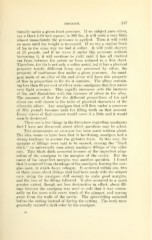Page 649 - My FlipBook
P. 649
AMALGAM. 317
tinnally under a given fixed pressure. If we subject pure silver,
say a block 1-10 inch square, to 300 lbs., it will yield a very little
almost immediately the pressure is applied. Then it will yield
no more until the weight is increased. If we try a similar block
of tin in the same way we find it softer. It will yield sharply
at 25 pounds, and if we leave it under this pressure without
increasing it, it will continue to yield until it has all crawled
out from between the points or been i-educed to a thin sheet.
Therefore, the tin is not only a softer metal, but it has a physical
property totally different from any possessed by silver, the
property of continuous flow under a given pressure. An amal-
gam made of an alloy of tin and silver will have this property
of flow in proportion to the tin it contains. The alloys contain-
ing less than 60 per cent of silver make amalgams that flow under
very light pressure. This rapidly increases with the increase
of tin, and diminishes with the increase of silver in the alloy.
The amounts of flow for the different proportions of tin and
silver are well shown in the table of physical characters of the
silver-tin alloys. Any amalgam that will flow under a pressure
of fifty pounds becomes imfit for filling teeth on that account.
Every stress of that amount would move it a little and it would
soon be destroyed.
There are a few things in the literature regarding amalgams
that I have not discussed, about which questions may be asked.
The spheroiding of amalgam has been much written about.
The idea seems to have been that in hardening, amalgam had a
strong tendency to assume the globular form. In this way, the
margins of fillings were said to be opened, causing the "black
ditch," so universally seen about amalgam fillings of the older
sort. This black ditch occurred because of the imperfect adap-
tation of the amalgam to the margins of the cavity. But the
cause of the imperfect margins was another question. I found
that it occurred from shrinkage of the amalgam, leaving the mar-
gins open, in which decay rebegan. It occurred within one, two
or three years about fillings that had been made with the utmost
care, using the amalgam stiff enough to make good margins,
and the loss of the filling followed. It also occurred to a much
greater extent, though not less destructive in effect, about fill-
ings because the amalgam was used so soft that it was contin-
ually on the move with every touch of the plugger, and sprung
away from the walls of the cavity. The spheroiding occurred
before the setting instead of during the setting. The teeth were
generally stained a dark color by the amalgam.
42


